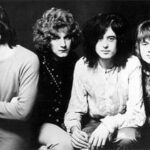Modern Broadway musical style originated in two stages: first, the formation of a new kind of music; second, the development of a new way of using music within a play.
The song that scholars most often cite as the one that established the basic character of modern American musical-theater songs is “They Didn’t Believe Me,” with music by Jerome Kern and lyrics by H. Reynolds (pseudonym of M.E. Rourke).
The song was interpolated into (added to) the 1914 New York City production of the English musical The Girl from Utah. “They Didn’t Believe Me” was more musically sophisticated than earlier American theater tunes, yet it also avoided the typical European flavor in the music of such well-schooled American operetta composers as Victor Herbert.
Through “They Didn’t Believe Me” and his many songs that followed, Kern became the acknowledged father and master of a new kind of theater music. It was a sophisticated, American-flavored style imitated by virtually all the great Broadway composers who followed him.
After revolutionizing the musical content of individual theater songs, Kern proceeded to revolutionize the musical structure of entire shows. The real breakthrough came in 1915 when he began to compose a series of history-making musicals for the little Princess Theater in New York City.
Because of the small size of the theater and the limited casts and sets, the productions had to be in a more intimate style than was typical of musicals at that time. In Nobody Home (lyrics, S. Greene and H. Reynolds, 1915) and Very Good, Eddie (lyrics, S. Greene, 1915), Kern molded the songs to fit individual characters and to help tell the story.
This integration of music, character, and story was not typical of the operettas and musicals of that time, which often stopped the story, if any, to perform irrelevant musical numbers. Kern continued to develop the principle of integration in the subsequent Princess Theater shows Oh, Boy! (lyrics, P.G. Wodehouse, 1917), including the song “Till the Clouds Roll By,” and Oh, Lady! Lady! (lyrics, P.G. Wodehouse, 1918).
The culmination of Kern’s integration development was Show Boat (1927), often cited as the first modern American serious musical play. Working with his librettist, Oscar Hammerstein II, Kern wrote songs, including the classic “Ol’ Man River,” that were integral to the atmosphere, the plot, and the characterizations. Even the background music was important.
For example, when the character Julie appeared for the second time, the accompanying music foreshadowed, even in the midst of a happy scene, her coming disaster. Throughout the score, themes referring to specific characters and concepts were quoted and developed in an almost operatic fashion. Show Boat, in fact, became the first Broadway musical to enter the repertory of a major opera company (New York City Opera, 1954).
Kern’s pioneering work in integration techniques profoundly influenced later Broadway composers. Arguably the greatest was Richard Rodgers, who became famous for his supreme artistry in fusing music and story in his musicals, such as Oklahoma! (1943), The King and I (1951), and The Sound of Music (1959).
By establishing the basic nature of modern American musical-theater songs and by integrating the technical details and emotional ambience of his music with the demands of plot development and character motivation, Jerome Kern originated a Broadway musical style that continues to flourish right up to the present day.
(Principal source: Darryl Lyman, Great Jews in Music, Jonathan David Publishers, www.jdbooks.com)





